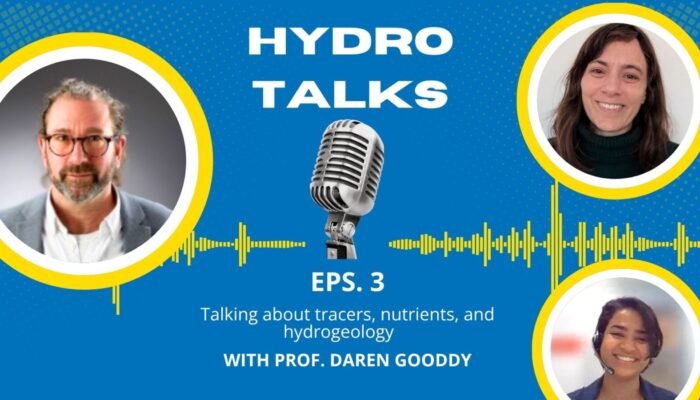
HydroTalks: Prof. Daren Gooddy talking about groundwater nutrients, contaminants and tracers
Welcome to HydroTalks, the EGU HS division’s podcast series where we discuss advancements, challenges, and opportunities in hydrology.
In this episode, we chatted to Prof. Daren Gooddy (Daren Gooddy|LinkedIn). Prof. Gooddy is a hydro-geochemist with over 30 years of experience as a groundwater processes team leader in the British Geological Survey. He’s currently working with the UK Centre of Ecology. His research encompasses groundwater chemistry and understanding contaminant fate and transport in changing hydrological systems under anthropogenic stresses.
You can check out the podcast below, or read the interview summary in this blog!
Your research looks at how agricultural chemicals have changed nutrient cycles in water systems. Can you tell us about your motivations?
A key motivation of my research when I first started was the impact of nitrogen on ecosystems, which can cause phenomena such as algal blooms. Nitrogen pollution can also impact human health. For instance, in the last five to ten years number of publications suggested that high concentration of nitrate in our diet can cause cancer. Speaking more broadly, pesticides are a major concern. Once they make their way into rivers or coastal waters they harm non-target organisms higher up the food-chain.
I am primarily a water chemist and I‘m interested in the interface between surface waters and groundwater because that is where generally a lot of interesting biogeochemistry takes place. Increasingly over the years, I have done more surface water work and recently I started looking at pollutant dispersal in the downstream estuaries.
What other concerning chemicals are getting into groundwater from land? And how are they getting in there in the first place?
Our view of organic contaminants evolves with analytical advances and now we can detect contaminants in trace concentrations. Pesticides have remained a long-standing concern and these days attention is focusing more on “emerging” organics, notably PFAS, the so-called “forever chemicals”. We know very little about their fate and transportation and their long-term ecological and environmental impacts, which should be a future research focus.
How these chemicals get into the groundwater depends on the geology of a region – whether it’s fractured, porous or mixed media. The important consideration is that nitrate and pesticides do not travel in the same way as water molecules. For example nitrate can accumulate in the porous unsaturated zone. We need to look at particular cases to understand how contaminants move.
One of the key methods you work on are groundwater tracers. Can you explain what they are and how they help track groundwater movement?
There are two main types of tracers. Qualitative tracers are chemicals that tell you if some water came from a certain time in history. Quantitative tracers are chlorofluorocarbons or sulfur hexafluoride. By measuring the quantity of these dissolved gases, we can estimate the groundwater residence time for up to 50 to 60 years. For older groundwater we use radiocarbon dating for ages up to 50,000 years. We can track source and migration pathway of contaminants using these tracers.
Looking into the future, how will climate change alter nutrient cycles in groundwater?
With climate change, we expect warmer winters and wetter summers in places like the UK, and that will change when and how rainfall recharges groundwater. We will get more hydrological extremes, like droughts and floods and unpredictable changes in water cycles.
More intense rainfall can push nitrates through the unsaturated zone more quickly, so contaminants that once took decades to reach the water table could arrive in years. Rising temperature can increase the soil biogeochemical activities, causing more natural processing of nutrients, such as denitrification in soil, producing nitrous oxide, a greenhouse gas. We need scientists trained to tackle these complex and linked feedbacks as a team.
In your opinion, what have been the biggest breakthroughs in hydrological research in the last 10 years? What big trends do you foresee for the next 10 years?
In the last 15 to 20 years we have understood a lot about the dynamics and biogeochemical processes of surface water-groundwater interface. Going forward, I believe we need to understand a lot more about the huge microbial biomass in the subsurface. I would like to see more work on environmental DNA techniques in groundwater.
Could you share the best and worst piece of career advice you ever received?
The best piece of career advice I ever received was that if you are going to write a paper, make sure it is useful and, in the abstract, make sure you include some numbers. In terms of bad advice, I might have either forgotten or ignored it.
Listen to the full HydroTalk podcast for more insights from Prof. Daren Gooddy. Stay tuned for upcoming episodes exploring the frontiers of hydrology.




